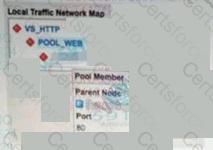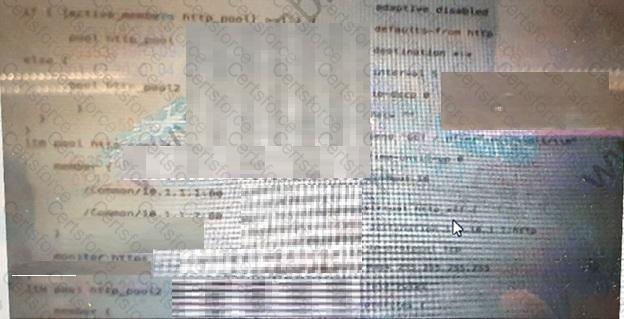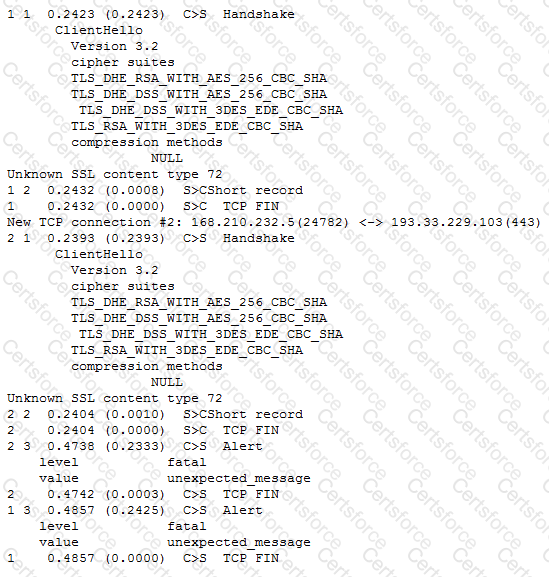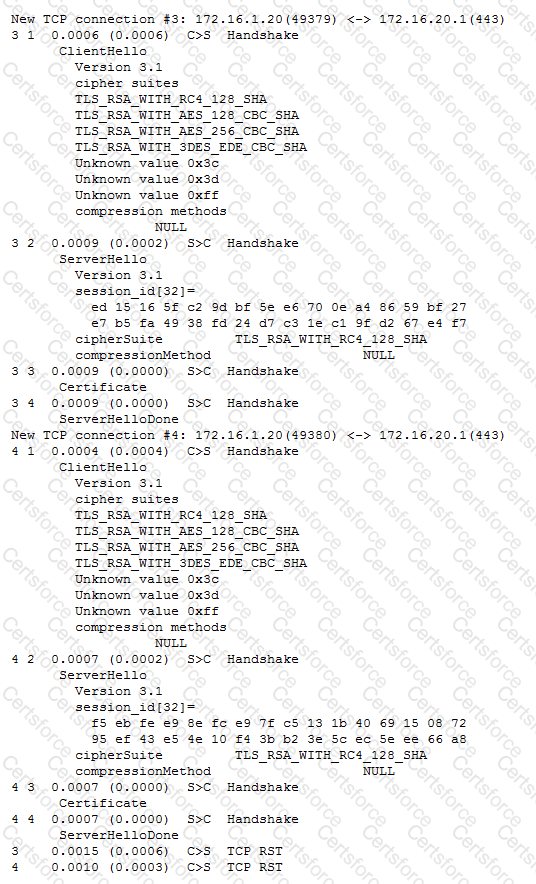Refer to the exhibit.

Why is the virtual server responsive to incoming connections?
A failover event is recorded in the log messages:
Jan 01 00:00:50 BIG-IP notice sod[5855]: 01140029:5: HA proc_running tmm fails action is go offline and down links.
Jan 01 00:00:50 BIG-IP notice sod[5855]: 010c0050:5: Sod requests links down.
Jan 01 00:00:50 BIG-IP notice sod[5855]: 010c0054:5: Offline for traffic group /Common/traffic-group-1.
Jan 01 00:00:50 BIG-IP notice sod[5855]: 010c003e:5: Offline
Jan 01 00:00:50 BIG-IP notice logger: /usr/bin/tmipsecd --tmmcount 4 ==> /usr/bin/bigstart stop racoon
Jan 01 00:00:50 BIG-IP info lacpd[5502]: 01160016:6: Failover event detected. (Switchboard failsafe disabled while offline)
Jan 01 00:00:51 BIG-IP err bcm56xxd[5296]: 012c0010:3: Failover event detected. Marking external interfaces down. bsx.c(3633)
Jan 01 00:00:51 BIG-IP info bcm56xxd[5296]: 012c0015:6: Link: 1.1 is DOWN
Jan 01 00:00:56 BIG-IP notice mcpd[5318]: 0107143c:5: Connection to CMI peer 10.0.0.3 has been removed
Jan 01 00:00:56 BIG-IP notice mcpd[5318]: 0107143a:5: CMI reconnect timer: enabled
Jan 01 00:00:56 BIG-IP notice mcpd[5318]: 01071431:5: Attempting to connect to CMI peer 10.0.0.3 port 6699
What is the cause of the failover?
Refer to the exhibit

Given the bigip conf extract shown where the servers only talk http on port 80, which node will receive thenext user request?
An LTM Specialist upgrades the switchinginfrastructure and the backend servers on the LAN segments.
The LTM Specialist notices a 20% memory usage increase on the BIG-IP device while handling the same number of concurrent connections.
A comparison of statistics pre-upgrade and post-upgrade showsa significant reduction on the following:
-RTT between the BIG-IP device and the backend servers
-Packet drops in the switch
Time to First Byte (TTFB)
The LTM Specialist is concerned with the scalability of the number of concurrent connections with the newmemory usage.
Which setting should be changed to reduce the memory usage on the BIG-IP device?
An LTM Specialist realizes that a datacenter engineer has changed the console baud rate.
Which command determines the current baud rate via the command line interface?
What is the correct command to reset an LTM device to its default settings?
ABIG IP system load balances connections to a web application. A TCP-based Denial of Service attack against the web application is occurring, which has caused very high memory utilization on the LTM device due to stale TCP connections.
Which TCPprofile option should be used to reduce memory utilization?
-- Exhibit –

-- Exhibit --
Refer to the exhibit.
A client attempts to connect from a Google Chrome browser to a virtual server on a BIG-IP LTM. The virtual server is SSL Offloaded. When the client connects, the client receives an SSL error. The client receives the same errors when trying Mozilla Firefox and Internet Explorer browsers.
The LTM Specialist does an ssldump on the virtual server and receives the results as per the exhibit.
How should this be resolved?
The output of a tmsh command is: ------------------------------------------------------------ Net::Interface Name Status Bits Bits Errs Errs Drops Drops Colli In Out In Out In Out sions ------------------------------------------------------------ 1.1 down 0 0 0 0 0 0 0 1.2 up 191.4K 0 0 0 374 0 0 1.3 down 0 0 0 0 0 0 0 1.4 up 22.5K 0 0 0 44 0 0 2.1 miss 0 0 0 0 0 0 0 2.2 miss 0 0 0 0 0 0 0 mgmt up 43.2G 160.0G 0 0 0 0 0
Which command was executed on the LTM device to show the output?
An LTM Specialist needs to gather website statistics such as latency and throughput on the existing virtual server. This virtual server loadBalances the backend web servers.
Which F5 feature will provide this?
-- Exhibit --

-- Exhibit --
Refer to the exhibit.
A company uses a complex piece of client software that connects to one or more virtual servers (VS) hosted on an LTM device. The client software is experiencing issues. An LTM Specialist must determine the cause of the problem. The LTM Specialist has the tcpdump extract. The client loses connection with the LTM device.
Where is the reset originating?
A new BIG-IP VE is deployed with default settings. The BIG-IP Administrator completes the setup utility in the Configuration Utility. The internal self IP address fails to respond to a ping request. What is a possible cause of this issue?
A web application requires the client to provide the destination server and service identification.
Which HTTP header will supply this information?
A client is attempting to log in to a web application that requires authentication. The following HTTP headers are sent by the client:
GET /owa/ HTTP/1.1
Authorization: Basic dXNlcm5hbWU6cGFzc3dvcmQ=
User-Agent: curl/7.26.0
Host: 10.0.0.14
Accept: */*
Accept-EncodinG. gzip,deflate
The web server is responding with the following HTTP headers:
HTTP/1.1 401 Unauthorized
Content-TypE. text/html
Server: Microsoft-IIS/7.5
WWW-AuthenticatE. NTLM
DatE. Wed, 16 Aug 1977 19:12:31 GMT
Content-LengtH. 1293
The client has checked the login credentials and believes the correct details are being entered.
What is the reason the destination web server is sending an HTTP 401 response?
An LTM Specialist is troubleshooting an issue with a new virtual server. When connecting through the virtual server, clients receive the message "Unable to connect" in the browser, although connections directly to the pool member show the application is functioning correctly. The LTM device configuration is:
ltm virtual /Common/vs_https {
destination /Common/10.10.1.110:443
ip-protocol udp
mask 255.255.255.255
pool /Common/pool_https
profiles {
/Common/udp { }
}
translate-address enabled
translate-port enabled
vlans-disabled
}
ltm pool /Common/pool_https {
members {
/Common/172.16.20.1:443 {
address 172.16.20.1
}
}
}
What issue is the LTM Specialist experiencing?